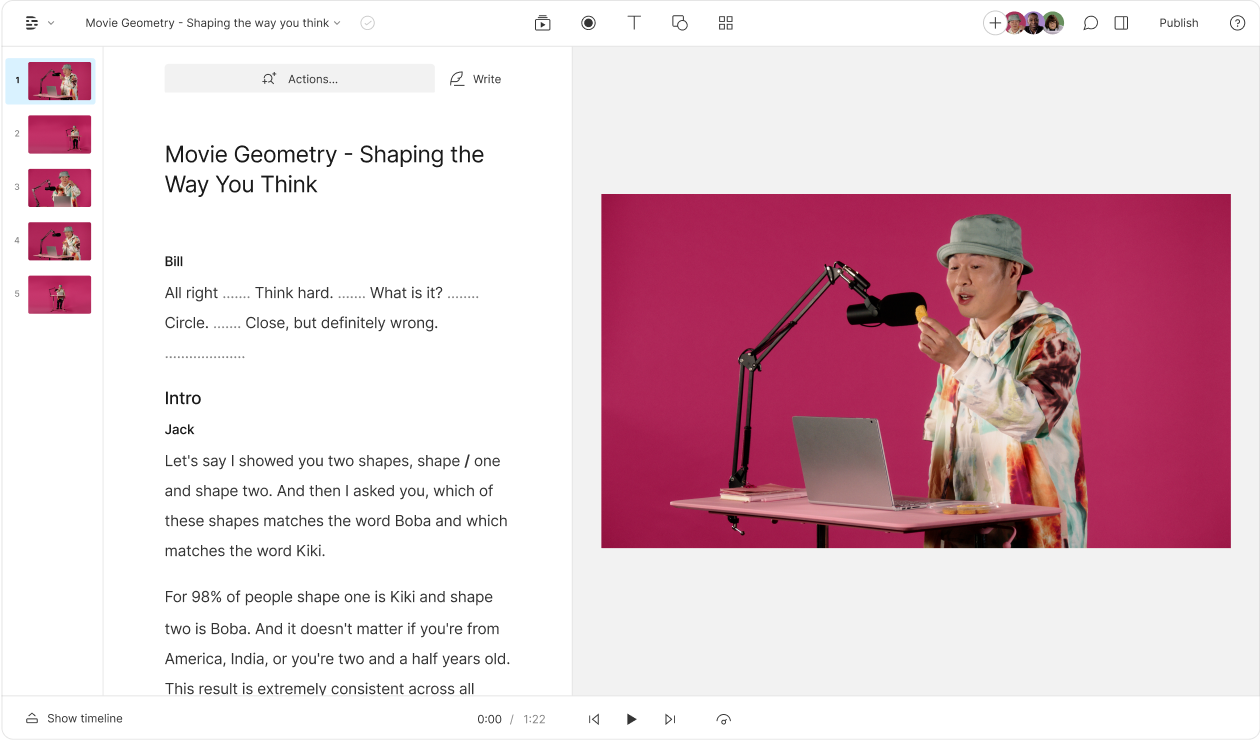What type of content do you primarily create?




Descript’s new AI video editor, a reborn Underlord, has been turned loose—anybody can try it now, in Labs. It’s the first of its kind: an AI agent built into a fully powered video editor.
That means you can now create or edit a video just by telling Underlord what you want.
The new Underlord understands what a good video looks and sounds like. It knows how to do anything you’d do in Descript. And it can execute entire editing workflows—like generating a rough cut, styling all the visuals, adding B-roll, and applying AI effects like Eye contact and Studio sound—from a single prompt.
As with most any creative tool, but especially with an AI agent like Underlord: trial and error is the best way to learn how to use it. So if you haven’t already, go give it a try.
That said, this is all new, and it may not be obvious where to start or how to get the most out of it. So we’ve gathered a few tips and ideas from our team and the Descript power users who’ve been testing the new Underlord.
The basics: Getting started with Underlord
Conversation, not commands
Sure, Underlord can do anything you tell it to do in Descript. But to get the most out of it, try asking questions or explaining what you're trying to achieve before you just start ordering it around.
“Talk to it like a person. This is your creative partner to chat with and create ideas with,” says Mario Salazar, host of the women’s soccer podcast Casual FC.
Be explicit where you want to be, but don’t worry about giving step-by-step directions. Try telling Underlord what you have in mind, and trust that it knows how to get there; it will use its judgment and make choices that fit your vision.
Be specific, and generous, with context
Here's where you should provide a lot of detail. Just like a human co-editor, Underlord is far more likely to give you satisfying results if you tell it exactly what you're after. So give it as much detail as you can about the kind of video you want, the platform you’ll be publishing to, and the audience you’re aiming for. It will tailor its responses and actions to whatever you describe.
“For example, instead of ‘cut this down,’ say something like ‘make this a fast-paced highlight reel for TikTok with a humorous tone, that’s less than 60 seconds,’” says Katrina Lui, a Descript software engineer helping to build Underlord.
Use positive language
Much like a two-year-old, Underlord responds better when you tell it what to do rather than what not to do. That’s true whether you’re giving creative direction or asking it to complete a task. So instead of “Make this script sound less robotic,” try something like this:
Always be iterating
Another way Underlord is like a human co-editor: it can misunderstand or misinterpret what you tell it. So if your initial prompt doesn't work, don't just repeat it (or give up)—try coming at it from a different angle.
Jethro Jones, host of the podcast Transformative Principal, discovered this when he was asking Underlord to cut down an interactive Zoom course so that it only contained the parts where he was talking. After that didn’t work, he flipped it.
“I told it to remove everybody that wasn't me from the conversation,” he says. Underlord knocked that out “in lightning speed.”
Descript’s head of product, Laura Burkhauser, was having trouble getting Underlord to style her social clips in bulk. So she tried asking Underlord to style the main composition first and then cut clips—worked like a charm.
Prompt your way through
If you’re not getting the results you want from Underlord. If Underlord does or something you can’t understand, or weren’t expecting. If you don’t know what your next move should be. If you know what you want it to be but don’t have the video knowledge or terminology to describe it. If you’re just generally confused or unsure.
In any of these situations, just prompt your way through. One of the incredible things about this whole AI thing is its ability to work with you to sort out your thoughts, give you suggestions and even troubleshoot its own work.
The next level: Refining your prompts
Workflows: start with simple tasks, then build as you go
Jethro has one monster prompt he uses with every episode of his show—it clips out the beginning of the recording, applies automatic multicam, adds chapter markers, and make a few other time-consuming edits.
“ It does about 90% of the work for me,” he says. “Being able to just copy and paste that in and then I'm done editing is pretty amazing.”
But he didn’t start that way—instead, he dipped a toe in by testing individual prompts and refining them until each one worked every time. Then he tried putting a few together, then a few more, until he had the end-to-end prompt he uses today.
Consult other AI tools
If you're struggling to write prompts, or can’t get Underlord to understand you, try consulting with ChatGPT or another AI tool. Two synthetic brains can be better than one, it seems.
“I like to conference with ChatGPT or Claude on putting together a good prompt because they’re good at writing a ton of context,” Laura says. “And editing that context is easier than writing it myself.”
Make Underlord check its own work
Before you get caught in a cycle where you prompt Underlord, then have to prompt it to fix the thing it broke when it did the first thing, try getting ahead of the issue: make Underlord double-check its work.
The fun stuff: Pushing your creative boundaries with Underlord
Think bigger, not just faster
Use Underlord to make new stuff, not just as an efficiency multiplier. Think beyond your current workflow: if you had an assistant with unlimited bandwidth, good taste, and deep expertise, what would you ask it to do? Then ask Underlord to do it.
Our early power users leaned on Underlord to make trailers, video podcasts, courses, social media clips, translations—stuff that was either beyond their skillsets or just too time-consuming before.
Experiment with generated media
Underlord can search Descript’s stock media library when you want to add an image. But stock is, by definition, generic. If you want to create something unique, ask Underlord to generate the exact image (and soon video) you want.
“Think about it like being able to custom order stock media,” Laura says.
For optimal, non-slop results, be ultra specific—for Underlord, no amount of contextual detail is too much.
Find Underlord’s limits—and keep going
Got a crazy idea you think could never work, or that you’re pretty sure Underlord can’t handle? Try asking it anyway.

Conclusion: If at first you don’t succeed, keep asking
We’re giving Underlord new capabilities and powers every day. And it’s learning from all the things you and your Descript peers are asking it to do. So if it completely fails at something today, try asking again next week. “You might be surprised what it can do,” Laura says.























%201.svg)





